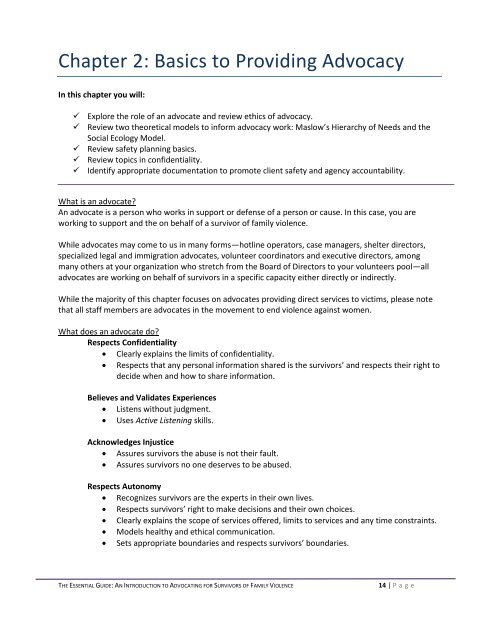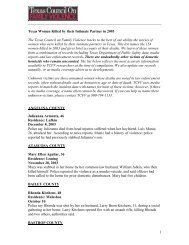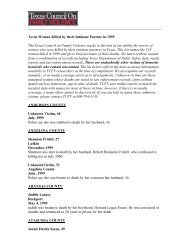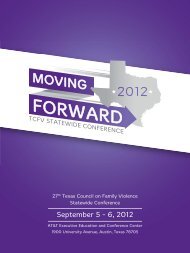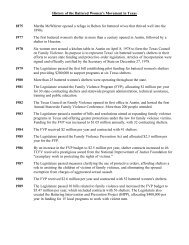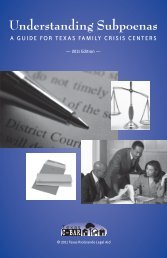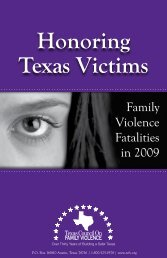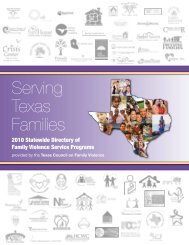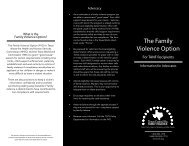the essential guide - Texas Council on Family Violence
the essential guide - Texas Council on Family Violence
the essential guide - Texas Council on Family Violence
You also want an ePaper? Increase the reach of your titles
YUMPU automatically turns print PDFs into web optimized ePapers that Google loves.
Chapter 2: Basics to Providing AdvocacyIn this chapter you will: Explore <str<strong>on</strong>g>the</str<strong>on</strong>g> role of an advocate and review ethics of advocacy. Review two <str<strong>on</strong>g>the</str<strong>on</strong>g>oretical models to inform advocacy work: Maslow’s Hierarchy of Needs and <str<strong>on</strong>g>the</str<strong>on</strong>g>Social Ecology Model. Review safety planning basics. Review topics in c<strong>on</strong>fidentiality. Identify appropriate documentati<strong>on</strong> to promote client safety and agency accountability.What is an advocate?An advocate is a pers<strong>on</strong> who works in support or defense of a pers<strong>on</strong> or cause. In this case, you areworking to support and <str<strong>on</strong>g>the</str<strong>on</strong>g> <strong>on</strong> behalf of a survivor of family violence.While advocates may come to us in many forms—hotline operators, case managers, shelter directors,specialized legal and immigrati<strong>on</strong> advocates, volunteer coordinators and executive directors, am<strong>on</strong>gmany o<str<strong>on</strong>g>the</str<strong>on</strong>g>rs at your organizati<strong>on</strong> who stretch from <str<strong>on</strong>g>the</str<strong>on</strong>g> Board of Directors to your volunteers pool—alladvocates are working <strong>on</strong> behalf of survivors in a specific capacity ei<str<strong>on</strong>g>the</str<strong>on</strong>g>r directly or indirectly.While <str<strong>on</strong>g>the</str<strong>on</strong>g> majority of this chapter focuses <strong>on</strong> advocates providing direct services to victims, please notethat all staff members are advocates in <str<strong>on</strong>g>the</str<strong>on</strong>g> movement to end violence against women.What does an advocate do?Respects C<strong>on</strong>fidentiality Clearly explains <str<strong>on</strong>g>the</str<strong>on</strong>g> limits of c<strong>on</strong>fidentiality. Respects that any pers<strong>on</strong>al informati<strong>on</strong> shared is <str<strong>on</strong>g>the</str<strong>on</strong>g> survivors’ and respects <str<strong>on</strong>g>the</str<strong>on</strong>g>ir right todecide when and how to share informati<strong>on</strong>.Believes and Validates Experiences Listens without judgment. Uses Active Listening skills.Acknowledges Injustice Assures survivors <str<strong>on</strong>g>the</str<strong>on</strong>g> abuse is not <str<strong>on</strong>g>the</str<strong>on</strong>g>ir fault. Assures survivors no <strong>on</strong>e deserves to be abused.Respects Aut<strong>on</strong>omy Recognizes survivors are <str<strong>on</strong>g>the</str<strong>on</strong>g> experts in <str<strong>on</strong>g>the</str<strong>on</strong>g>ir own lives. Respects survivors’ right to make decisi<strong>on</strong>s and <str<strong>on</strong>g>the</str<strong>on</strong>g>ir own choices. Clearly explains <str<strong>on</strong>g>the</str<strong>on</strong>g> scope of services offered, limits to services and any time c<strong>on</strong>straints. Models healthy and ethical communicati<strong>on</strong>. Sets appropriate boundaries and respects survivors’ boundaries.THE ESSENTIAL GUIDE: AN INTRODUCTION TO ADVOCATING FOR SURVIVORS OF FAMILY VIOLENCE14 | P a g e


